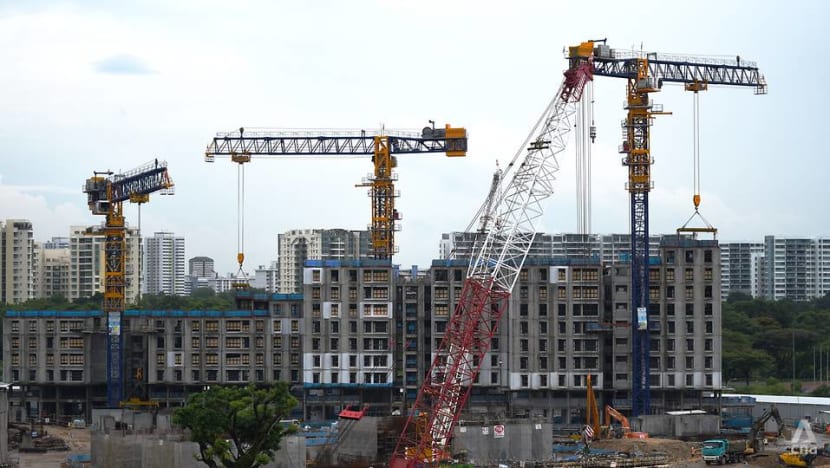Commentary: Why do workplace accidents keep repeating themselves in Singapore?
Workers falling from heights, stepping onto false ceiling boards and getting struck by forklifts – accidents like these have typically occurred before, under similar circumstances. Employers are not reflecting and acting enough, says NUS Associate Professor Goh Yang Miang.

Construction cranes seen at a construction site in Singapore on May 18, 2020. (File photo: Calvin Oh)
SINGAPORE: The uptick in workplace fatalities in 2022, which stands at 30 as of Jul 15, has concerned labour groups and non-governmental organisations. There were 28 workplace deaths in the first six months of this year, compared to 17 in the same period in 2019, before the COVID-19 pandemic.
Moreover, there were more than 9,000 workplace safety breaches that the Ministry of Manpower (MOM) took action against in the first half of 2022 – double the number in the same period last year.
As industry observers say, every life lost is one too many. We rely on these workers to build our homes and keep our power grids and transport systems running smoothly, so it is critical we do more to protect them.
But if we examine workplace accidents, most, if not all, have precedents, like workers falling from heights, stepping onto false ceiling boards and getting struck by forklifts.
On May 12, Workplace Safety and Health (WSH) Council general manager Christopher Koh said seven out of the 20 workplace fatalities at that point in time are “repeat cases”, with similar accidents in the previous year.
MOM minister Dr Tan said in Parliament on Jul 4 that “most of these accidents were due to preventable safety lapses such as inadequate control measures or lack of adherence to safe work procedures".
So why do preventable accidents keep repeating themselves?
ORGANISATIONS HAVE NO MEMORY
Professor Trevor Kletz, a British chemical engineering safety expert, famously said accidents recur because “organisations have no memory”.

Whenever there is a workplace fatality, the WSH Council will alert the industry, providing timely information about the accidents so other organisations can learn from the accident and prevent a recurrence.
However, sharing of information does not equate to learning. Sharing of accident cases can raise workers’ awareness in the short run, but it is frequently not sustainable, and the awareness depletes after some time especially with pressure from manpower shortages and tighter deadlines.
An organisation learns from an accident only if they go through these stages: Obtaining the accident details, reflecting on the accident, drawing lessons from the reflection, and implementing the lessons learned in the workplace.
This requires organisations to adopt “double-loop learning” instead of “single-loop learning”. The latter is focused on the specifics of a situation whereas in the former, the organisation reflects on the values, assumptions and policies that influenced the actions that led to the outcome.
As an example of single-loop learning, after a worker falls from a defective ladder, the employer removes the defective ladder and briefs workers on the safe use of ladders. Here, the improvement made is superficial.
In double-loop learning, the employer examines deeper causes of the ladder defect, such as ladder procurement, maintenance and inspection. They evaluate safety training effectiveness, workers’ perception of management’s commitment to workplace safety and whether work pressure is excessive.
Once the underlying causes of the accident are exposed, more effective measures can then be identified and implemented to prevent a recurrence.
Double-loop learning is not the norm in the industry. Many of the investigation reports I have seen displayed clear signs of single-loop learning.
For instance, one indicated the “root cause” of worker getting struck by a falling object as the failure of the lifting hook. In another near-miss report, the “root cause” was that the employee did not inform the site manager the temperature of the equipment had increased.
The failure of the lifting hook and the omission of safety communication are not root causes because they do not identify the assumptions and practices that led to them in the first place. Single-loop learning keeps safety management problems hidden, increasing the likelihood of a repeat accident.
A LACK OF SAFETY CULTURE
The tendency for single-loop learning points to a broader lack of safety culture in companies and industries.
Frontline personnel are sensitive to management priorities. Israeli professor Dov Zohar found that safety climate – employees’ perception of how much the organisation’s values, policies, procedures and practices indicate its commitment to safety – is a reliable predictor of safety performance.
When managers do not emphasise safety constantly, it can lead to supervisors and workers not prioritising the time and effort needed to learn from accidents and implement safety measures. Even when effective measures are identified in investigative reports, they may not be implemented.
When there is a lack of safety culture, workers also tend not to report hazards and incidents. Worse still, they accept the hazards, and their risk perception is distorted.
Many accidents do not result in fatalities and might even go unreported if there was no severe injury.
An even more fundamental issue is the lack of a culture of excellence. Many organisations are not on the lookout for opportunities for improvement.
In the book The Power of Habit: Why We Do What We Do in Life and Business, American author Charles Duhigg describes how the former CEO of industrial corporation Alcoa, Paul O’Neil, declared in his first shareholders meeting that he wanted zero injuries.
O’Neil was using safety as an indicator of whether the organisation is pursuing excellence. He believed that to improve safety, the company must learn from accidents and design work processes that are easy to follow. To him, “correct work is also safer work”.
By the time, O’Neill left Alcoa in 2000, Alcoa was not only one of the safest companies in the world, but its annual net income was five times larger than when O’Neil joined the company.
MANAGERS NEED TO STEP UP
Notably, the Alcoa case study does not mention safety officers. There is probably a group of safety personnel behind the scenes, but the focus is on management and employees.
To improve oversight on workplace safety, MOM is reviewing the coverage of WSH personnel on the ground. In fact, a large number of such personnel can lead to the perception that safety and operations are separate.
Safety officers should play the role of in-house consultants to support safety management. Managers and supervisors should be the ones reflecting on accidents, evaluating work procedures and implementing the lessons learned to ensure good practices are institutionalised.

There are managers with different levels of safety commitment. There are exemplary managers who go beyond expectations, but there are others who need more nudging and guidance.
The upcoming Approved Code of Practice (ACOP) for Company Director’s WSH Duties, through which authorities can hold managers accountable in upkeeping safety standards, can potentially be a useful nudge.
But more needs to be done by other stakeholders to highlight the importance of our workers’ safety and health.
Businesses and members of public should research contractors’ backgrounds in deciding whether to engage their services. MOM’s database, CheckSafe, allows anyone to review a company’s accident records. The WSH Council grants annual WSH awards to showcase exemplary companies.
If companies with good safety records are rewarded with more business opportunities, managers will pay more attention to safety.
It is also critical for institutes of higher learning to ensure that all graduates, especially those entering high-risk sectors like construction, manufacturing, ship building, and oil and gas, understand the importance of protecting our workers. Graduates should recognise how prioritising safety is beneficial to organisations.
After all, they will be the next generation of leaders with the power to ask themselves, “What can I do to prevent a recurrence of these accidents?”
Dr Goh Yang Miang is Associate Professor with the Safety and Resilience Research Unit (SaRRU) at the Department of the Built Environment, National University of Singapore, where he is also the Director of the Centre for Project and Facilities Management.


















